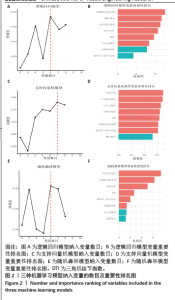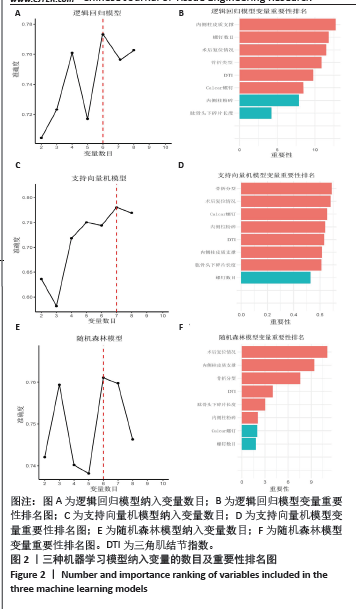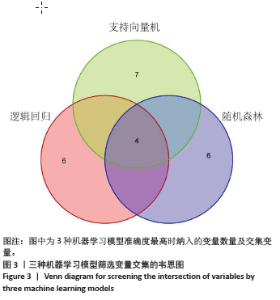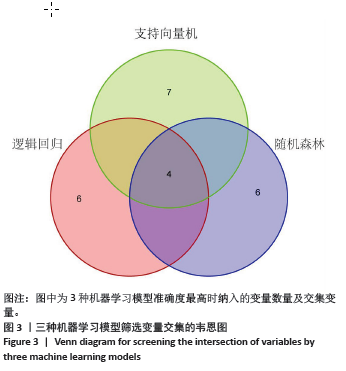Chinese Journal of Tissue Engineering Research ›› 2025, Vol. 29 ›› Issue (15): 3179-3187.doi: 10.12307/2025.169
Previous Articles Next Articles
Machine learning prediction of the risk of secondary screw perforation after plate internal fixation for proximal humerus fractures
Xu Daxing1, 2, Tu Zesong2, 3, Ji Muqiang2, Xu Weipeng3, Niu Wei4
- 1Applicants with Equivalent Academic Qualifications for Doctoral Degrees, Guangzhou University of Chinese Medicine, Guangzhou 510006, Guangdong Province, China; 2Department of Orthopedics, Sanshui Hospital of Foshan Hospital of Traditional Chinese Medicine, Foshan 528100, Guangdong Province, China; 3Department of Orthopedics, Foshan Hospital of Traditional Chinese Medicine, Foshan 528000, Guangdong Province, China; 4Department of Articular Surgery, Guangdong Provincial Hospital of Chinese Medicine, Guangzhou 510120, Guangdong Province, China
-
Received:2024-02-01Accepted:2024-04-17Online:2025-05-28Published:2024-11-05 -
Contact:Niu Wei, MD, Chief physician, Doctoral supervisor, Department of Articular Surgery, Guangdong Provincial Hospital of Chinese Medicine, Guangzhou 510120, Guangdong Province, China -
About author:Xu Daxing, MD, Assciate chief physician, Applicants with Equivalent Academic Qualifications for Doctoral Degrees, Guangzhou University of Chinese Medicine, Guangzhou 510006, Guangdong Province, China; Department of Orthopedics, Sanshui Hospital of Foshan Hospital of Traditional Chinese Medicine, Foshan 528100, Guangdong Province, China -
Supported by:Medical Science and Technology Research Foundation in Guangdong Province, No. B2023493 (to XDX); High-Level Medical Key Speciality Construction Project during the 14th Five-Year Plan in Foshan, Key Specialty Construction Project of Traditional Chinese Medicine during the 14th Five-Year Plan in Foshan, Medical Key Speciality Construction Project during the 14th Five-Year Plan in Sanshui (Department of Orthopedics, Sanshui Branch of Foshan Hospital of Traditional Chinese Medicine), No. 202KJS09 (to TZS)
CLC Number:
Cite this article
Xu Daxing, Tu Zesong, Ji Muqiang, Xu Weipeng, Niu Wei. Machine learning prediction of the risk of secondary screw perforation after plate internal fixation for proximal humerus fractures[J]. Chinese Journal of Tissue Engineering Research, 2025, 29(15): 3179-3187.
share this article
Add to citation manager EndNote|Reference Manager|ProCite|BibTeX|RefWorks
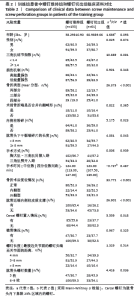
2.1 参与者数量分析 训练组 214 例患者和外部验证组 61 例患者全部进入结果分析,样本无脱落。 2.2 训练组患者基线特征比较 螺钉维持组平均年龄(58.29±10.90)岁,螺钉切出组平均年龄(60.98±9.66)岁,差异无显著性意义(t=1.686,P=0.093)。随访时间6-12个月,平均(8.44±2.21)个月,发生继发性螺钉切出关节面患者61例,比例为28.5%。螺钉切出组29例患者出现继发肩峰下撞击,其中单纯螺钉撞击14例,9例并发肱骨头塌陷,4例并发肱骨头内翻移位,2例并发内固定松动。关节粘连患者18例,肱骨头坏死8例,骨不连3例,2例出现表浅软组织感染,门诊换药后痊愈。二期手术翻修率为20%(12/61),其中6例因肱骨头坏死行肩关节置换术,5例行单纯切出螺钉取出,1例患者内固定重新翻修。风险变量中两组患者年龄、性别、损伤机制、术前骨折端有无内翻畸形、手术方式、手术时间、是否植骨、螺钉长度比较,差异无显著性意义(P > 0.05);DTI、骨折类型(Neer分型)、肱骨内侧柱粉碎、肱骨头下干骺端碎片的长度、骨折术后复位情况、肱骨近端内侧柱皮质支撑、肱骨距螺钉置入、肱骨头螺钉数量比较差异有显著性意义(P < 0.05)。见表2。 2.3 机器学习算法筛选术后螺钉继发性切出风险变量 应用3种机器学习算法对表2中有统计学意义的8个风险变量进行分析。模型准确度最高的纳入风险变量数量中,逻辑回归模型中纳入6个风险变量;支持向量机模型纳入7个风险变量;随机森林模型纳入6个风险变量,模型纳入变量的数目及重要性排名图见图2。3种机器算法筛选的交集变量共4个:肱骨近端内侧柱皮质支撑、DTI、骨折类型、骨折术后复位情况,韦恩图见图3。"
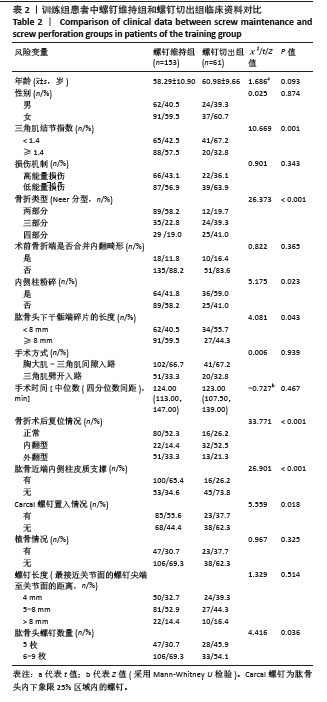
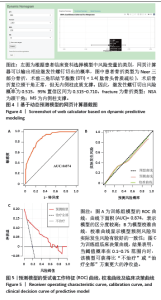
2.4 风险预测模型的构建 将DTI、骨折类型、骨折术后复位情况、肱骨近端内侧柱皮质支撑4个风险变量在Rstudio软件中构建逻辑回归方程,构建动态预测模型的网页计算器(https://xdx594.shinyapps.io/DynNomapp/)预测发生继发性螺钉切出关节面的风险,见图4。临床应用时,可在网页输入每例患者相应的临床资料进行个性化风险预测,每个风险变量对应的分数相加通过网页计算器获得总分数,得到对应的风险概率,预测概率越高,螺钉切出风险越大。 2.5 风险预测模型的内部验证 内部验证用Bootstrap法重抽样1 000次,ROC曲线的曲线下面积为0.874[95%置信区间(0.827,0.922)],证明模型有较好的区分度(图5A)。模型的校准曲线证实模型预测风险和实际发生风险有较好的一致性(图5B)。临床决策曲线分析表明,当阈值概率在 0.1-0.75 范围内时,该模型可获得比“不治疗”或“治疗全部”方案更大的净收益,意味着模型有较好的临床适用性(图5C)。 "

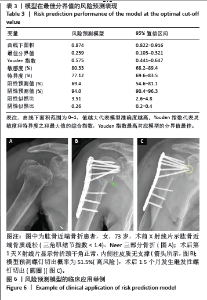
2.6 风险预测模型的临床风险分层 模型在风险分层的最佳分界值ROC曲线结果表明,螺钉切出风险概率为26%时对应Youden指数最佳值为0.57,模型的敏感度、特异度、阳性预测值、阴性预测值、阳性似然比和阴性似然比分别为80.33%,77.12%,69.4%,94.0%,3.51和0.26,见表3。因此,当螺钉切出风险概率> 26%,归为高风险组;风险概率≤26%时,归为低风险组。临床医生可根据患者不同的风险概率,制定个性化治疗方案。高风险组的患者应考虑单锁定钢板固定的替代方案(如双钢板固定、钢板联合异体腓骨或肩关节置换术等)以防止继发性螺钉切出的发生;而低风险组应常规采用单锁定钢板手术治疗,以避免过度医疗带来的手术风险和高额费用。 2.7 风险预测模型的临床应用举例 图6的典型病例可具体解释模型的临床应用。女性患者,73岁,术前X射线片提示骨折类型为Neer三部分骨折、肱骨近端骨质疏松(DTI < 1.4),术后第1天X射线片提示骨折复位颈干角正常,但内侧柱皮质无支撑。经过动态预测模型计算患者螺钉继发性切出概率为51.5%,属于高风险患者。患者在术后1.5个月随访时发生螺钉继发性切出肱骨头关节面,证明模型预测准确度较高。 2.8 风险预测模型的外部验证 外部验证组由佛山市中医院三水医院2013年6月至2022年6月符合纳入和诊断标准的61例肱骨近端骨折行切开复位锁定钢板内固定患者组成,其中男25例,女36例;平均年龄(64.82±4.02)岁。随访期间17例患者出现继发性螺钉切出,占比为28%;其中8例出现继发肩峰下撞击;关节粘连6例,肱骨坏死2例。二期手术翻修发生率为29%(5/17),其中3例患者因肱骨头坏死行二期关节置换,2例单纯切出螺钉取出。将验证组实际发生螺钉切出人数和模型预测螺钉切出人数对比,模型预测术后螺钉切出12例,实际发生螺钉切出17例,误判5例,分类正确率为71%(12/17)。模型预测术后螺钉维持患者39例,实际44例,分类正确率为89%(39/44),总正确率为84%(51/61)。 "
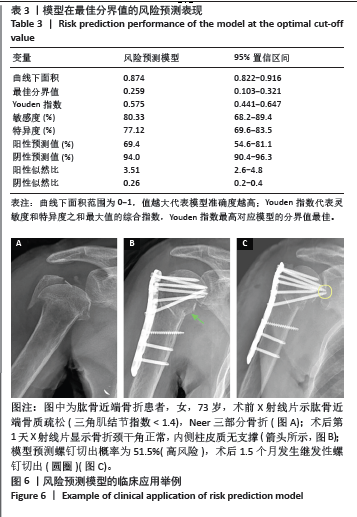
| [1] KOKKALIS ZT, PAPANIKOS E, BAVELOU E, et al. Avoiding Complications of Locking Plating for Proximal Humerus Fractures. J Long Term Eff Med Implants. 2022;32(3):73-81. [2] CIRIC D, MISCHLER D, QAWASMI F, et al. Secondary Perforation Risk in Plate Osteosynthesis of Unstable Proximal Humerus Fractures: A Biomechanical Investigation of the Effect of Screw Length. J Orthop Res. 2019;37(12):2625-2633. [3] FLEISCHHACKER E, SIEBENBURGER G, HELFEN T, et al. Varus malposition relates to functional outcomes following open reduction and internal fixation for proximal humeral fractures: A retrospective comparative cohort study with minimum 2 years follow-up. Injury. 2021;52(3):506-510. [4] FORURIA AM, MARTINEZ-CATALAN N, VALENCIA M, et al. Proximal humeral fracture locking plate fixation with anatomic reduction, and a short-and-cemented-screws configuration, dramatically reduces the implant related failure rate in elderly patients. JSES Int. 2021;5(6):992-1000. [5] LAPNER P, SHETH U, NAM D, et al. Management of Proximal Humeral Fractures in Adults: A Systematic Review and Meta-Analysis. J Orthop Trauma. 2023;37(2):e80-e88. [6] 李波, 熊文峰, 张世民. 锁定钢板治疗肱骨近端骨折中螺钉穿透关节面的研究进展[J]. 中国修复重建外科杂志,2021,35(4):403-408. [7] SUDKAMP N, BAYER J, HEPP P, et al. Open reduction and internal fixation of proximal humeral fractures with use of the locking proximal humerus plate. Results of a prospective, multicenter, observational study. J Bone Joint Surg Am. 2009;91(6):1320-1328. [8] 汪秋柯. 肱骨近端骨折分型与锁定钢板内固定术后继发性螺钉穿出的关系[D]. 上海:上海交通大学,2019. [9] 张明, 陈云丰, 胡海, 等. 肱骨近端骨折内固定术后螺钉穿出肱骨头的影响因素分析[J]. 中华创伤骨科杂志,2015,17(4):282-286. [10] 汪秋柯, 张明, 陈云丰. 肱骨近端骨折锁定钢板内固定术后螺钉穿出的影响因素及处理研究进展[J]. 中华创伤骨科杂志,2017,19(7):641-644. [11] 陈潮锋, 石宇雄, 梁锦成, 等. 基于机器学习算法预测全膝关节置换后住院时长[J]. 中国组织工程研究,2021,25(27):4300-4306. [12] 白皙, 罗云云, 周智博, 等. 基于机器学习算法的大于胎龄儿风险预测模型[J]. 中华流行病学杂志,2021,42(12):2143-2148. [13] 朱荣火, 黄晶晶, 黄鸿娜, 等. 基于四种机器学习算法建立预测肝癌切除术后复发模型[J]. 中西医结合肝病杂志,2023,33(3):202-208. [14] MIJDERWIJK HJ, BEEZ T, HANGGI D, et al. Clinical prediction models. Childs Nerv Syst. 2020;36(5):895-897. [15] CHEN L. Overview of clinical prediction models. Ann Transl Med. 2020;8(4):71. [16] MCMILLAN TE, JOHNSTONE A J. Primary screw perforation or subsequent screw cut-out following proximal humerus fracture fixation using locking plates: a review of causative factors and proposed solutions. Int Orthop. 2018;42(8):1935-1942. [17] 白求恩·骨科加速康复联盟, 白求恩公益基金会创伤骨科专业委员会, 白求恩公益基金会关节外科专业委员会, 等. 加速康复外科理念下肱骨近端骨折诊疗规范的专家共识[J]. 中华创伤骨科杂志,2020,22(3):187-196. [18] 林浩东, 傅慧超, 吴晓明. 《2021版老年肱骨近端骨折治疗指南》解读[J]. 中华创伤杂志,2022,38(9):834-839. [19] 汪秋柯, 陈云丰. 浅谈肱骨近端骨折的分型[J]. 国际外科学杂志,2017, 44(11):727-730. [20] SPROSS C, KAESTLE N, BENNINGER E, et al. Deltoid Tuberosity Index: A Simple Radiographic Tool to Assess Local Bone Quality in Proximal Humerus Fractures. Clin Orthop Relat Res. 2015;473(9):3038-3045. [21] HERTEL R, HEMPFING A, STIEHLER M, et al. Predictors of humeral head ischemia after intracapsular fracture of the proximal humerus. J Shoulder Elbow Surg. 2004;13(4):427-433. [22] HILL BW, JOYCE C D, SINGH A, et al. Patients With Mild Osteoarthritis Are Less Likely to Achieve a Clinically Important Improvement in Pain or Function After Anatomic Total Shoulder Arthroplasty. Clin Orthop Relat Res. 2023;481(8):1464-1470. [23] XU J, ZHAN S, LING M, et al. How can medial support for proximal humeral fractures be achieved when positioning of regular calcar screws is challenging? Slotting and off-axis fixation strategies. J Shoulder Elbow Surg. 2022;31(4):782-791. [24] FLETCHER J, WINDOLF M, GRUNWALD L, et al. The influence of screw length on predicted cut-out failures for proximal humeral fracture fixations predicted by finite element simulations. Arch Orthop Trauma Surg. 2019; 139(8):1069-1074. [25] GLANS M, KEMPEN T, JAKOBSSON U, et al. Identifying older adults at increased risk of medication-related readmission to hospital within 30 days of discharge: development and validation of a risk assessment tool. BMJ Open. 2023;13(8):e70559. [26] 徐凌霄, 刘俊, 韩春霞, 等. 基于机器学习的重症股骨颈骨折患者死亡风险预测模型构建和验证[J]. 同济大学学报(医学版),2022,43(6):812-818. [27] KITCHARANANT N, CHOTIYARNWONG P, TANPHIRIYAKUN T, et al. Development and internal validation of a machine-learning-developed model for predicting 1-year mortality after fragility hip fracture. BMC Geriatr. 2022;22(1):451. [28] 何继业, 张家红, 蔡贵泉, 等. 锁定钢板治疗不稳定肱骨近端骨折术后内翻的危险因素分析[J]. 中华创伤杂志,2020,36(5):448-454. [29] KIM DM, PARK D, KIM H, et al. Risk Factors for Severe Proximal Humerus Fracture and Correlation Between Deltoid Tuberosity Index and Bone Mineral Density. Geriatr Orthop Surg Rehabil. 2020;11:1864664671. [30] SPROSS C, ZELEDON R, ZDRAVKOVIC V, et al. How bone quality may influence intraoperative and early postoperative problems after angular stable open reduction-internal fixation of proximal humeral fractures. J Shoulder Elbow Surg. 2017;26(9):1566-1572. [31] LORENZ G, SCHÖNTHALER W, HUF W, et al. Complication rate after operative treatment of three- and four-part fractures of the proximal humerus: locking plate osteosynthesis versus proximal humeral nail. Eur J Trauma Emerg Surg. 2021;47(6):2055-2064. [32] WANG Q, ZHU Y, LIU Y, et al. Correlation between classification and secondary screw penetration in proximal humeral fractures. PLoS One. 2017;12(9):e183164. [33] JUNG SW, SHIM SB, KIM HM, et al. Factors that Influence Reduction Loss in Proximal Humerus Fracture Surgery. J Orthop Trauma. 2015;29(6):276-282. [34] HAWS BE, SAMBORSKI SA, KARNYSKI S, et al. Risk factors for loss of reduction following locked plate fixation of proximal humerus fractures in older adults. Injury. 2023;54(2):567-572. [35] AGUDELO J, SCHÜRMANN M, STAHEL P, et al. Analysis of efficacy and failure in proximal humerus fractures treated with locking plates. J Orthop Trauma. 2007;21(10):676-681. [36] GARDNER MJ, WEIL Y, BARKER JU, et al. The importance of medial support in locked plating of proximal humerus fractures. J Orthop Trauma. 2007; 21(3):185-191. [37] WEEKS CA, BEGUM F, BEAUPRE LA, et al. Locking plate fixation of proximal humeral fractures with impaction of the fracture site to restore medial column support: a biomechanical study. J Shoulder Elbow Surg. 2013; 22(11):1552-1557. [38] WANG Q, SHENG N, RUI B, et al. The neck-shaft angle is the key factor for the positioning of calcar screw when treating proximal humeral fractures with a locking plate. Bone Joint J. 2020;102-B(12):1629-1635. [39] 常祖豪, 张伟, 唐佩福, 等. 内侧支撑重建增强固定技术在肱骨近端骨折治疗中的研究进展[J]. 中国修复重建外科杂志,2021,35(3):375-380. [40] SUN Q, WU X, WANG L, et al. The plate fixation strategy of complex proximal humeral fractures. Int Orthop. 2020;44(9):1785-1795. |
| [1] | Li Jiagen, Chen Yueping, Huang Keqi, Chen Shangtong, Huang Chuanhong. The construction and validation of a prediction model based on multiple machine learning algorithms and the immunomodulatory analysis of rheumatoid arthritis from the perspective of mitophagy [J]. Chinese Journal of Tissue Engineering Research, 2025, 29(在线): 1-15. |
| [2] | Wang Mi, Ma Shujie, Liu Yang, Qi Rui. Identification and validation of characterized gene NFE2L2 for ferroptosis in ischemic stroke [J]. Chinese Journal of Tissue Engineering Research, 2025, 29(7): 1466-1474. |
| [3] | Liu Yani, Yang Jinghuan, Lu Huihui, Yi Yufang, Li Zhixiang, Ou Yangfu, Wu Jingli, Wei Bing . Screening of biomarkers for fibromyalgia syndrome and analysis of immune infiltration [J]. Chinese Journal of Tissue Engineering Research, 2025, 29(5): 1091-1100. |
| [4] | Yang Bin, Tao Guangyi, Yang Shun, Xu Junjie, Huang Junqing . Visualization analysis of research hotspots of artificial intelligence in field of spinal cord nerve injury and repair [J]. Chinese Journal of Tissue Engineering Research, 2025, 29(4): 761-770. |
| [5] | Yang Dingyan, Yu Zhenqiu, Yang Zhongyu. Machine learning-based analysis of neutrophil-associated potential biomarkers for acute myocardial infarction [J]. Chinese Journal of Tissue Engineering Research, 2025, 29(36): 7909-7920. |
| [6] | Chen Ying, Guo Xiaojing, Mo Xueni, Ma Wei, Wu Shangzhi, Li Xiangling, Xie Tingting. Analysis of diagnostic biomarkers for ischemic stroke and experimental validation of targeted cuproptosis related genes [J]. Chinese Journal of Tissue Engineering Research, 2025, 29(35): 7562-7570. |
| [7] | Gong Yuehong, Wang Mengjun, Ren Hang, Zheng Hui, Sun Jiajia, Liu Junpeng, Zhang Fei, Yang Jianhua, Hu Junping. Machine learning combined with bioinformatics screening of key genes for pulmonary fibrosis associated with cellular autophagy and experimental validation [J]. Chinese Journal of Tissue Engineering Research, 2025, 29(35): 7679-7689. |
| [8] | Hu Chaoran, Cen Chaode, Yang Yang, Zhou Cheng, Huang Huaxian, Yuan Honghao, Luo Qin, Cao Yongfei. 3D printing assisted minimal invasive plate osteosynthesis versus intramedullary nail for treatment of AO12-C middle-proximal humeral fractures [J]. Chinese Journal of Tissue Engineering Research, 2025, 29(33): 7116-7122. |
| [9] | Li Jing, Lu Guangqi, Zhuang Minghui, Cui Ying, Yu Zhangjingze, Sun Xinyue, Ma Mingming, Zhu Liguo, Yu Jie. Development of a clinical prediction model for cervical instability in young and middle-aged adults based on machine learning [J]. Chinese Journal of Tissue Engineering Research, 2025, 29(33): 7203-7210. |
| [10] | Tian Yushi, Fu Qiang, Li Ji . Bioinformatics identification and validation of mitochondrial genes related to acute myocardial infarction [J]. Chinese Journal of Tissue Engineering Research, 2025, 29(31): 6697-6707. |
| [11] | Liang Jiyao, Zhou Honghai, Wei Guikang, Su Shaoting, Chen Longhao, He Xinyu, Liu Liangpu. Quantification of in vivo biomechanics and analysis of influencing factors in cervical spine fixed-point rotation manipulation [J]. Chinese Journal of Tissue Engineering Research, 2025, 29(3): 486-492. |
| [12] | Song Haoran, Zhang Yuqiang, Gu Na, Zhi Xiaodong, Wang Wei. Visualization analysis of artificial intelligence in bone trauma research based on Citespace [J]. Chinese Journal of Tissue Engineering Research, 2025, 29(3): 493-502. |
| [13] | Zhang Ziyu, Chen Longhao, Sheng Wei, Lyu Hanzhe, Shen Ying, Wang Binghao, Lyu Zhizhen, Lyu Lijiang. Application of artificial intelligence in the diagnosis and treatment of lumbar disc herniation: evolution towards standardization, efficiency, and precision of diagnosis and treatment methods [J]. Chinese Journal of Tissue Engineering Research, 2025, 29(29): 6269-6276. |
| [14] | Wang Jiaru, Zhang Ying, Yang Yong, Qi Wen, Xiao Huaye, Ma Qiuping, Yang Lianzhao, Luo Ziwei, He Yaqing, Zhang Jiangyin, Wei Jiawen, Meng Yuan, Tan Silian. Systematic review of machine learning models for predicting functional recovery and prognosis in stroke [J]. Chinese Journal of Tissue Engineering Research, 2025, 29(29): 6317-6325. |
| [15] | Hao Maochen, Ma Chao, Liu Kai, Liu Kexin, Meng Lingting, Wang Xingru, Wang Jianzhong. Bioinformatics screening of key genes for endoplasmic reticulum stress in osteoarthritis and experimental validation [J]. Chinese Journal of Tissue Engineering Research, 2025, 29(26): 5632-5641. |
| Viewed | ||||||
|
Full text |
|
|||||
|
Abstract |
|
|||||
